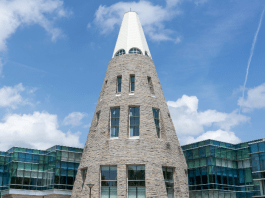An Eclipse viewing party is planned at Ivy Tech Evansville, on Aug. 21, from the beginning of the Eclipse through the end. Led by Michael Hosack, assistant professor of physics at Ivy Tech, Ivy Tech students and the public will have the opportunity to learn about the Eclipse as they are viewing it.
The event, “It’s a New Day at Ivy Tech,†will take place from 11:55 p.m. (CST) to 2:49 p.m. (CST) with maximum coverage at 1:24 p.m., on Monday, Aug. 21. The viewing party will be located on Ivy Tech’s northeast parking lot, at the corner of Colonial Avenue and Tremont Road on the Ivy Tech Campus at 3501 N. First Avenue in Evansville. The event is free and open to the public.
“We are pleased to be able to share our faculty’s expertise with our students and members of the community, during this unusual Eclipse which is occurring not only here – but across the United States,†said Chancellor Jonathan Weinzapfel. “Our faculty member, Dr. Hosack, is looking forward to sharing his insight in a safe and informative environment, as the moon passes between the earth and the sun.â€
Hosack has been with Ivy Tech since 2013. Prior to Ivy Tech, he was a visiting assistant professor of physics at Purdue University, and worked for three years at NASA’s Goddard Space Flight Center, as a scientist working on radiation detectors for satellites. He will lead an informal discussion intermittently as the first hour of the Eclipse is viewed.
Free ISO certified solar viewing glasses and souvenir t-shirts will be provided by Ivy Tech while supplies last. Also at the event will be materials to make small pinhole projectors for group or individual viewing of the eclipse. The solar glasses and the projector are the only safe ways to view the eclipse.
According to the website, “Great American Eclipse,†solar eclipses occur because of a cosmic coincidence: “the Sun is just about the same apparent size in our sky as the Moon. While the sun is actually about 400 times larger in diameter that the moon, the moon is also about 400 times closer than the sun. Therefore, the sun and moon appear to be about the same size in our sky.†The coming Eclipse is special because “it will be accessible to so many millions of Americans…There is a 60 to 70 mile wide path of totality,†according to the website. This year’s Eclipse is special because it cuts diagonally across the entire United States. The last time a total solar eclipse swept the whole width of the U.S. was in 1918.
Totality will cross from Oregon to Idaho, Wyoming, Nebraska, Kansas, Missouri, Illinois, Kentucky, Tennessee, Georgia, North Carolina, and South Carolina.
Evansville is not in that path of totality, but individuals will be able to see an Eclipse that covers 99% of the sun. The next total solar Eclipse that will be in the U.S. will occur on April 8, 2024. The line of totality will cross from Texas, up through the Midwest, almost directly over Indianapolis, Cleveland, Buffalo, NY, and over New England to Maine, then to Canada.
For those with questions, please contact Marsha Jackson, at mjackson353@ivytech.edu



